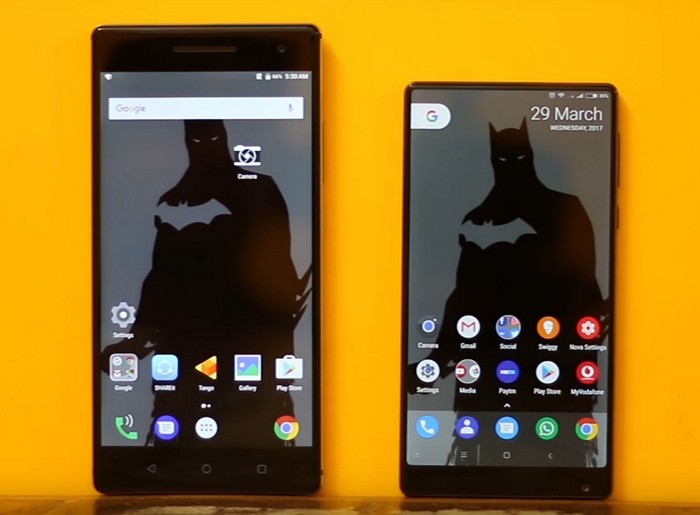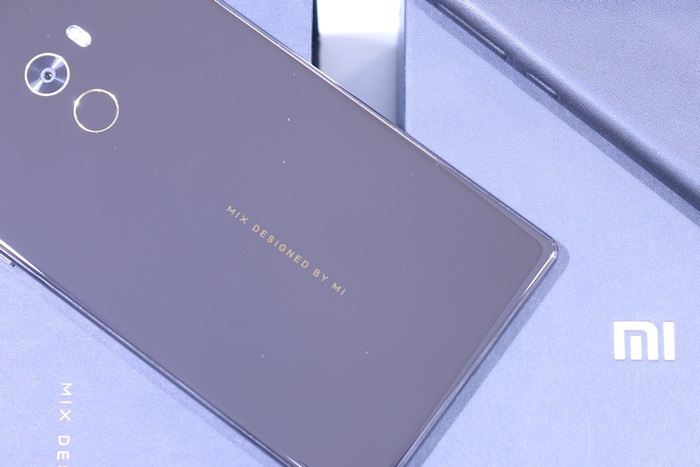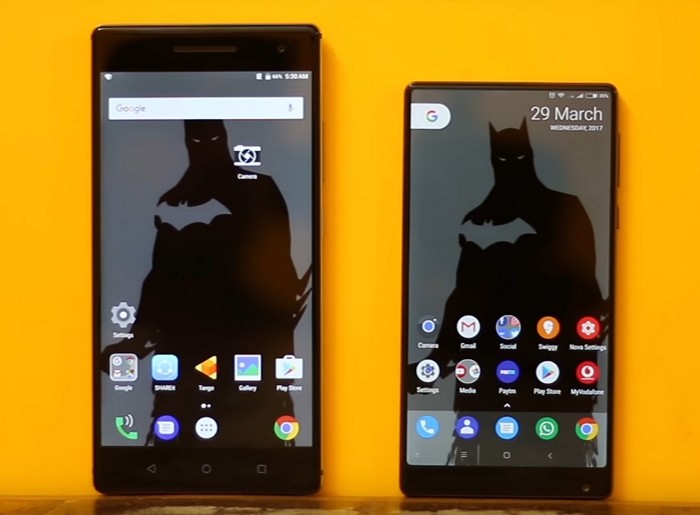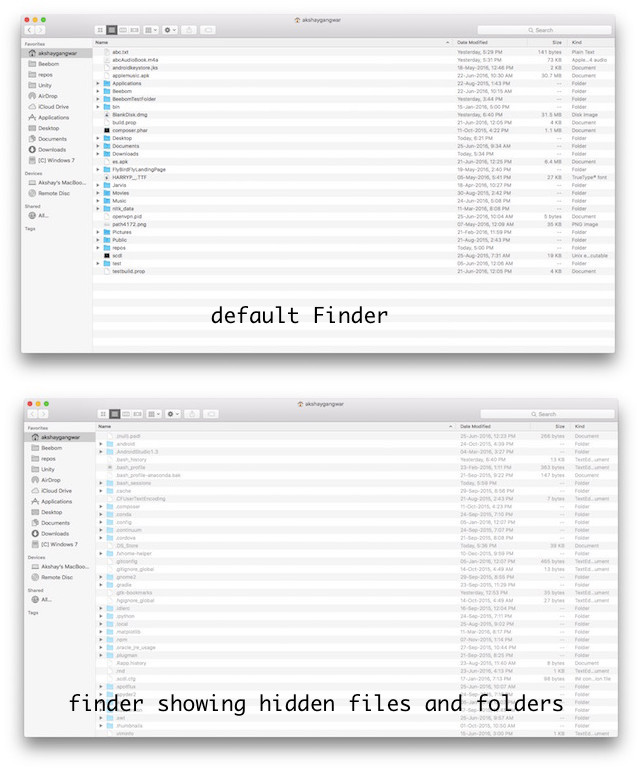
Xiaomi astonished the world with the Mi Mix debut last year. Originally introduced as a concept, the company’s subsequent pricing and availability announcements caught everyone off guard. Why the surprise? Because Mi Mix marked the pioneering move towards nearly bezel-less smartphones by a renowned manufacturer. While several Chinese counterparts, such as the Sharp Aquos Crystal and Aquos Crystal 2, had already ventured into bezel-less designs, Mi Mix emerged as the foremost contender for the masses. Although the Xiaomi device remains primarily accessible in China and limited in quantity, alternative procurement routes exist for interested buyers (available on GearBest at $619, as of now). Having recently acquired the Mi Mix, it has since become my daily driver for several weeks. So, does Mi Mix’s bezel-less design truly signal the future of smartphones? Let’s delve into the specifics to ascertain.
Xiaomi Mi Mix Specifications
Let’s delve into the Xiaomi Mi Mix specifications:
| Dimensions | 158.8 x 81.9 x 7.9 mm |
| Weight | 209 grams |
| Display | 6.4-inch IPS LCD (1080 x 2040 pixels) |
| Processor | Quad-core MSM8996 Snapdragon 821, Adreno 530 GPU |
| RAM | 4/6 GB |
| Storage | 128/256 GB |
| Cameras | 16 MP f/2.0 rear camera with phase-detection autofocus, dual-tone LED flash, gyro-based EIS; 5 MP f/2.2 front-facing camera |
| Battery | 4,400 mAh, QuickCharge 3.0 |
| Android | MIUI 8 on Android 6.0 Marshmallow |
| Sensors | Fingerprint scanner, cantilevered piezoelectric actuator, ultrasound proximity, gyroscope, compass, accelerometer |
| Connectivity | Dual SIM, WiFi dual band 802.11 a/b/g/n/ac, Bluetooth 4.2, USB Type C, USB OTG, NFC |
| Price | ~$619 |
On paper and from appearances, the Mi Mix appears to blend innovative design with high-end specs. But does this translate into a stellar smartphone? Let’s delve.

What’s Included
The Mi Mix arrives in an aesthetically pleasing box with gold-accented text, mirroring the device’s style. It’s minimalistic, which I appreciate. Contents of the box include:
- Xiaomi Mi Mix
- Leather case
- USB Type C cable
- Power Adapter
- SIM ejector tool
- Booklets
Design and Hardware
Xiaomi smartphones boast excellent designs and build quality, with the Mi Mix arguably standing out as the most stunning creation from the Chinese manufacturer. Upon first glance, the back of the device captivates with its ceramic material and mirror-like finish, exuding a mesmerizing allure. However, its beauty comes with a drawback—it readily attracts fingerprints and is exceptionally slippery, necessitating the inclusion of a case by Xiaomi. Nonetheless, the ceramic body, along with the engraved “Mix Designed by Mi,” contributes to its premium aesthetic, ensuring it embodies the essence of a flagship device.
The ceramic back includes a 16 MP camera and a dual-tone LED flash, along with a fingerprint scanner. In the 256 GB version of the Mi Mix, all elements on the back feature Gold accents, complementing the glossy ceramic finish.
At the front, the edge-to-edge display captivates with its sleek design. The nearly bezel-less screen boasts an impressive 83.6% screen-to-body ratio. Rounded edges, reminiscent of the LG G6 and Galaxy S8, add to its appeal. Notably, the front-facing camera, positioned at the bottom, detracts from the aesthetics. However, an absence of the proximity sensor and earpiece is compensated for with innovative technology. Xiaomi utilizes a piezoelectric actuator behind the display for audio output, replacing the traditional earpiece. Additionally, the inclusion of an ultrasound proximity sensor marks a milestone in smartphone technology. In summary, this device showcases cutting-edge advancements.
The Mi Mix frame, including the button, is ceramic, creating a seamless feel. The power/lock and volume rockers are on the right, while the left side features the SIM tray. The top has the 3.5 mm jack, and the bottom features the USB Type C port and speaker.
Thanks to fewer bezels, the device measures 158.8 x 81.9 x 7.9 mm, similar to the iPhone 7 Plus (158.2 x 77.9 x 7.3 mm) and Pixel XL (154.7 x 75.7 x 8.5 mm). However, while the latter two have 5.5-inch displays, the Mi Mix has a 6.4-inch display. Here’s a comparison with the Lenovo Phab 2 Pro, which also has a 6.4-inch display:
Thanks to the impressive screen-to-body ratio, you get a compact phone with ample screen estate. However, the smartphone can be challenging to hold due to its slippery back. Overall, the Xiaomi Mi Mix is a beautiful device and a dream come true for tech enthusiasts. Owning the Mi Mix is sure to attract attention.
Display
The Xiaomi Mi Mix features a sleek 6.4-inch IPS LCD display boasting a 1080 x 2040 pixel resolution, resulting in a sharp 362 ppi pixel density. Although the unconventional 17:9 aspect ratio occasionally leads to black bars during video playback, the abundance of pixels contributes to its visual appeal. The edge-to-edge design enhances the overall aesthetics, eliminating bezels entirely, particularly noticeable at the top. Despite discussions primarily focusing on the slim bezels, the Sharp display unit delivers impressive black levels, reminiscent of AMOLED screens. While the resolution may not match typical flagship standards, especially for a 6.4-inch display, its quality remains undeniable.
Firstly, the color reproduction and accuracy is excellent, along with clarity. The saturation is apparently increased, resulting in more pleasing colors. Xiaomi allows you to adjust the contrast and color saturation in the MIUI settings, enabling customization according to your preferences.
Thanks to the PenTile arrangement, the pixels remain invisible regardless of scrutiny. Regarding sunlight legibility, the display’s performance is average, as anticipated given its maximum brightness of 500 nits. Overall, the Mi Mix display appears satisfactory, save for one caveat: the auto brightness feature. Unfortunately, the auto brightness sensor in the Mi Mix proved ineffective, dimming in sunlight and brightening in darkness. Whether this issue stems from software or hardware remains uncertain; however, I disabled auto brightness shortly after initial use.
The Mi Mix boasts a nearly bezel-less display, which is its standout feature. Despite encountering an auto brightness issue, the display’s brilliance overshadows this flaw.
User Interface
Like all Xiaomi devices, the Mi Mix utilizes MIUI. While Chinese variants run on MIUI China ROM, the version I use operates on MIUI Global ROM, based on Android 6.0 Marshmallow. Despite Marshmallow’s age, its significance is negligible due to MIUI’s complete deviation from stock Android. Admittedly, as a devout stock Android user, I surprisingly find MIUI appealing, albeit with reservations. The absence of an app drawer irks me, given my penchant for installing numerous apps, cluttering the home screen. Moreover, the MIUI notification center presents a mixed experience; while the array of toggles is convenient, the inability to expand notifications for further details is a drawback.
MIUI undergoes a significant change from stock Android in its multitasking interface, resembling that of iOS and Windows Mobile. It’s functional but lacks the swift app-switching feature found in Nougat. Apart from that, MIUI includes its native apps such as phone, contacts, messaging, calendar, and browser. Their performance is satisfactory, and personal preference determines their appeal. I encountered no issues with them.
MIUI allows extensive customization. Exploring its Settings page reveals a myriad of options. For example, on the display front, features include double tap screen to wake, a reading mode that reduces blue light, and lock screen customizations.
MIUI introduces several useful features, including a native app locker and Child Mode for restricting access to certain apps. Additionally, there’s Quick Ball, accessible via the navigation bar, akin to iOS’ Assistive Touch. It offers shortcuts for screenshotting, navigating back, locking the phone, multitasking, and more. Users can customize gestures and select preferred shortcuts. Moreover, MIUI offers a one-handed mode, particularly useful for the large display of Mi Mix.
The “Second Space” feature stands out to me. It’s akin to multiple user accounts in stock Android, but notably superior. With Second Space, you create a distinct space, effortlessly transferring files, apps, data, and more. You can also monitor notifications from this space. For instance, if you’re managing multiple WhatsApp accounts, you’ll receive notifications for both. Alternatively, you can utilize the “Dual apps” feature to clone an app for multiple account usage.
MIUI is undeniably feature-rich, setting it apart from other Android skins by integrating genuinely useful features alongside a plethora of customization options beloved by many users. Thus, MIUI offers much to appreciate. Despite minor qualms, I am genuinely impressed by what MIUI brings to the table.
Performance
Among the Mi Mix’s technological advancements, it’s powered by last year’s flagship processor, the Quad-core MSM8996 Snapdragon 821, paired with the Adreno 530 GPU. It comes with either 4 GB or 6 GB of RAM, depending on the 128 GB or 256 GB variants. We’re using the 256 GB/6 GB version, and in my extensive usage, it performs like a flagship. MIUI did display “Settings has stopped” errors a couple of times, but overall, everything works swiftly, even with multiple extensive games.
Thanks to the massive amount of RAM, multitasking is effortless on the Mi Mix. Gaming performance is smooth without any stutter or frame drops. Unlike most phones with Qualcomm processors, the Mi Mix doesn’t suffer from overheating issues. Although it may get warm during processor-intensive games, it doesn’t overheat.
The real-world performance of the Mi Mix is impressive. While I don’t prioritize benchmarks, here are a few results:
The Mix performs well in both processor and GPU tests.
Getting the Mi Mix guarantees exceptional performance; the device excels and won’t disappoint in any usage scenario.
Telephony and Audio
While the Mi Mix is a stunning and capable smartphone, it falters in a fundamental aspect: the cantilevered piezoelectric actuator replacing the earpiece. The vibrational sound between the display and ceramic falls short. Sometimes it’s adequate, other times it disappoints for a modern smartphone. Initially, I suspected I was holding it incorrectly, but regardless of my adjustments, the sound remained insufficient. Moreover, I frequently experienced network drops, likely due to its primary design for Chinese networks.
Regarding the speakers, the bottom-facing ones on the Mi Mix are impressive. Despite being a single speaker, I was initially skeptical, but it delivered ample sound with decent clarity. Moreover, Xiaomi provides various headphone audio settings in MIUI, including an Equalizer, HD Sound audio, Mi Sound Enhancer, and more.
Battery Performance
The Mi Mix features a non-removable 4,400 mAh battery with support for Quick Charge 3.0. It includes a charger compatible with QC 3.0. While Xiaomi claims the charger can charge the phone to about 80% in half an hour, my experience was inconsistent. Sometimes, I achieved only 40-50% charge in thirty minutes, while other times, I reached 50%.
Regarding battery performance, it’s decent but has issues. During standby, the battery drains noticeably. For example, overnight from midnight to 10 AM, it dropped from 60% to 30%. Standby drain varies, sometimes holding up well, other times not. Apart from standby drain, battery performance is satisfactory but not exceptional.
During my usage, involving frequent YouTube video watching, occasional calls, extensive texting, social media browsing, and web page perusal, the Mi Mix maintained continuous synchronization, utilizing both mobile data and WiFi consistently. Despite heavy usage, the Mi Mix lasted approximately 19 hours. This endurance is commendable, although I remain hopeful that Xiaomi addresses the standby drain issue. In summary, the Mi Mix’s battery performance is satisfactory, especially considering not all users encounter the standby problem. The device can easily endure a day of moderate to heavy usage and potentially more for individuals with lighter phone usage.
Cameras
Let’s start with the rear camera. The Xiaomi Mi Mix features a 16 MP f/2.0 camera with phase-detection autofocus, dual-tone LED flash, and gyro-based EIS. Regarding the camera interface, it’s standard, especially for those familiar with MIUI.
The interface features toggles for flash, HDR, and a button to access filters, including modes such as Beautify, Audio, HHT, Straighten, Manual, Groupshot, and Titl-Shift. Particularly noteworthy is the Manual mode, enabling control over white balance, focus, exposure, and ISO. Camera settings offer additional options like face and age/gender detection, auto-exposure settings, using the volume button as a shutter key, focus mode, and automatic enhancement for low-light photos. Consistent with MIUI’s style, the camera app offers an array of options for experimentation.
Now, regarding the rear camera performance. In summary, it’s average. While it captures photos with good details, accurate colors, and dynamic range, there is some noise in some shots. Photos taken in good light are decent but upon closer inspection, they still feature some noise, which is disappointing. Besides the noise, the Mix captures decent photos, and HDR performs well. However, the Mi Mix’s OmniVision camera sensors struggle in low light and night shots. The photos in low light are average. Despite software processing making them appear brighter, they lack sharpness compared to flagship smartphones.
Here are some Mi Mix photos we took:
Concerning video capture, the Mix can shoot 4K videos at 30 fps, with stereo audio. The videos captured by the Mix are good. The details are present, akin to stills, and although the camera processing occasionally oversharpened, the video quality remains decent. Regarding audio, the Mix adequately captures it.
Regarding the selfie camera, it’s a 5 MP f/2.2 unit. The issue with the selfie camera is its placement at the bottom, resulting in an awkward angle for selfies. To use the selfie camera on the Mix, you must rotate your phone each time, even if screen rotation is disabled. Although I’m not an avid selfie-taker, I’ve found myself using the front-facing camera less frequently since using the Mix. This inconvenience is a trade-off for a bezel-less smartphone. In terms of photo quality, shots taken with the front-facing camera are below flagship standards.
Connectivity
Like most Xiaomi smartphones, the Mi Mix offers dual SIM support with LTE capability in both slots. However, using 4G LTE on one SIM disables it on the other. The device supports 11 LTE bands, catering primarily to the Chinese market, yet it seamlessly functions with Vodafone and Reliance JIO SIM cards.
Additionally, it boasts dual-band Wi-Fi a/b/g/n/ac, Wi-Fi Direct, Bluetooth 4.2, NFC, USB OTG, GPS with GLONASS and Beidou. Notably absent are IR blaster and FM Radio support. In essence, the Mi Mix’s connectivity suite encompasses all modern smartphone essentials.
Mi Mix: From Concept to Reality
Upon the unveiling of Xiaomi’s Mi Mix, I was awestruck, and chances are, so were you. A bezel-less smartphone has been a universal desire, and truthfully, I still adore the Mi Mix’s stunning design. Kudos to Xiaomi for this bold endeavor. We recognize Xiaomi as a purveyor of commendable smartphones and products that offer exceptional value. Yet, the Mi Mix stands out as a testament, earning my heightened respect for the company. It’s a daring move, and they’ve successfully made their mark. While I applaud their effort, the question remains: should you invest in a Mi Mix? In my opinion, the Mi Mix remains a concept phone. While it’s tangible, it’s not quite a polished product.
The bezel-less display and ceramic design are impressive, but critical trade-offs exist. The poor sound quality from the cantilevered piezoelectric actuator (earpiece replacement) and the awkward placement of the front-facing camera, along with auto-brightness issues, detract. Yet, if you can accept these flaws, the MI Mix won’t disappoint. Its performance is exceptional, speakers are good, and it’s attention-grabbing.
While numerous great smartphones compete with the Mix at the $600 price point, such as the LG V20, Huawei Mate 9, Galaxy S7 Edge, and Xiaomi’s Mi 5s, they lack the aura and edge-to-edge display of the Mix. So, if you live outside China and still want to buy the Mix, you can get it from GearBest. Priced at around $620 for the 256 GB/6 GB variant, the phone offers great value for money.
Special Offer for Beebom Readers: $609.99 with coupon code “MiMIXG” on GearBest.
Pros:
- Stunning Design
- Gorgeous Bezel-less Display
- Fluid Performance
- Base Version Features 128 GB Storage
- Value For Money
- Good Audio Quality
- MIUI Features
Cons:
- Poor Earpiece Sound (cantilevered piezoelectric actuator)
- Average Camera
- Front-Facing Camera Placement
- Auto-Brightness Issues
Exploring Mi Mix: Embracing the Bezel-Less Era
The Mi Mix, a pioneering smartphone, showcases a futuristic design. However, its bezel-less approach entails significant trade-offs, notably evident in poor earpiece sound and average camera quality. Moreover, issues with front-facing camera placement and auto-brightness further underscore the challenges of this innovative design. The question arises: are bezel-less smartphones truly the future, or is a balanced approach—like Samsung’s implementation in the Galaxy S8—preferable? We eagerly await your insights on the Mi Mix and the bezel-less trend in the comments below.

Pritam Chopra is a seasoned IT professional and a passionate blogger hailing from the dynamic realm of technology. With an insatiable curiosity for all things tech-related, Pritam has dedicated himself to exploring and unraveling the intricacies of the digital world.



